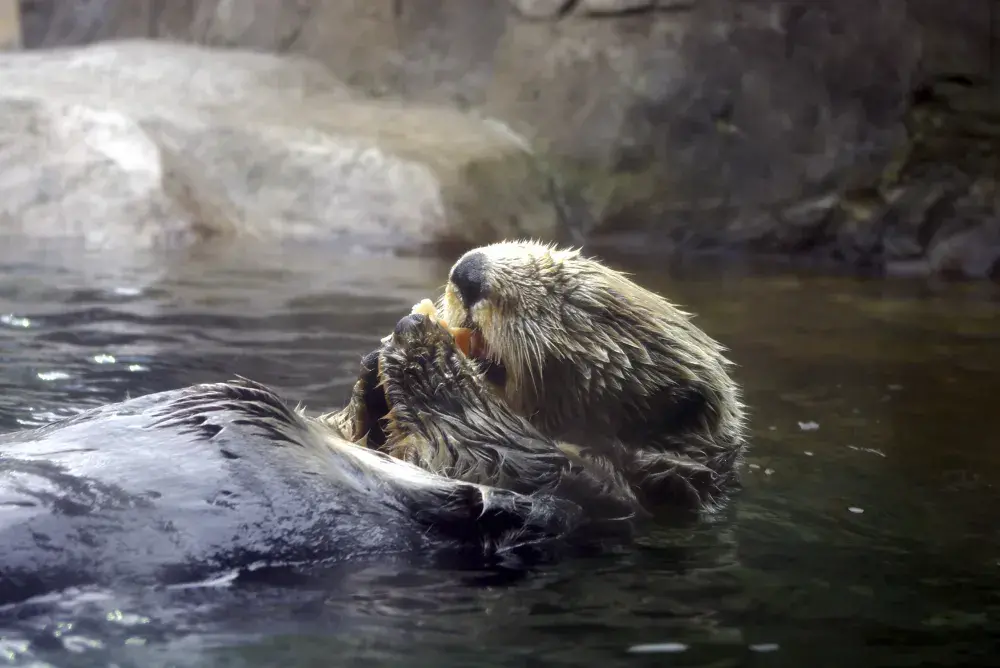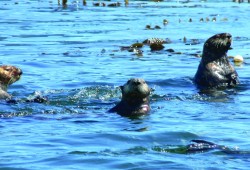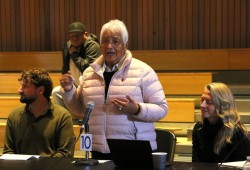Are they the adorable superheroes of the Pacific, or the “rats of the sea”? It depends on who you talk to, but the continued resurgence of sea otters on British Columbia’s coast has many who live off the ocean calling for an approach to control the population – including some methods that the general public might find hard to stomach.
Since being introduced to the B.C. coast over 50 years ago, the northern sea otter population has grown exponentially. But this has created concerns among Indigenous communities, as the sea otter is a particularly adept hunter with a voracious appetite for shellfish.
For the last decade the Coastal Voices initiative has studied issues affecting Indigenous food sovereignty on the West Coast. Guided by a steering committee of hereditary chiefs from northern coastal nations that include Ka:'yu:'k't'h'/Che:k'tles7et'h', as well as advisors from other Nuu-chah-nulth communities, some of Coastal Voices’ most recent work includes helping to rebuild traditional clam garden sites in Kyuquot Sound last summer.
Representatives from the initiative gave a presentation on Nov. 5 to the Nuu-chah-nulth Council of Ha’wiih Forum on Fisheries, which was hosted by the Mowachaht/Muchalaht First Nation in Tsaxana.
“After a summer of working on a clam garden we realized we had a lot to learn from our colleagues up north in Alaska about the role of other predators of sea otters,” said Anne Salomon from Coastal Voices during the forum. “Brown bears, orca, wolves and, of course, people as hunters are all predators of sea otters.”
With a fur density of up to 1 million hair folicles per square inch, sea otters have the thickest pelt of any marine mammal. Historically they were hunted by Nuu-chah-nulth-aht and other coastal tribes, but this activity intensified after colonial settlement on the North Pacific coast in the 1700s, as the sea otter pelts became a hot commodity on the European and Russian markets. As they were the best hunters, First Nations from Vancouver Island’s coasts were soon engaged to acquire pelts, and by the mid 1800s intensified trading brought the species to serious decline, leading eventually to the last reported sea otter kill on the B.C. coast in 1929. Since 1911 the animal has been protected by an international treaty.
Extinct on the B.C. coast, the mammal was reintroduced from 1969 to 1972, when 89 were incrementally moved from Alaska to Checlesat Bay in Ka:'yu:'k't'h'/Che:k'tles7et'h' territory. By 1972 sea otters were spotted from Haida Gwaii to Barkley Sound, according to a population report from the Committee on the Status of Endangered Wildlife in Canada. Over the following 50 years the B.C. population has grown to an estimated 8,000, with COSEWIC downgrading the sea otter’s designation from “endangered” to the current “special concern” status. Despite the exponential growth, this status means that the animal has “characteristics that make it particularly sensitive to human activities or natural events.”
“The species occupies 33-50 per cent of its historical range in British Columbia but is not yet clearly secure in Canada,” states the most recent COSEWIC assessment from 2022, noting that the main threat is oil contamination, which disturbs the otter’s insulating fur. “There are several potential sources of oil but the greatest risk is from shipping, which is expected to continue to increase into the foreseeable future. A major oil spill could affect very large portions of the current range, making the species especially vulnerable.”
The sea otter is a particularly adept hunter, using its hands to open shellfish with tools as the pinniped dives up to 30 metres deep. Adult males can grow to 45 kilograms, with a metabolism three times that of land mammals of a similar size. They eat up to one quarter of their body weight in a day.
The sea otters’ rapid population growth on the coast has brought concerns from Nuu-chah-nulth communities, as many are seeing a corresponding decline in shellfish.
“In Hesquiaht Harbour, boat basin we’re getting raped. Every night I see sea otters - we’re losing our clam beds,” said Hesquiaht member Preston Campbell during the fisheries forum. “That's our refrigerator that they're stealing from.”
Larry Swann noted that sea urchins, abalone and other shellfish once found near Ahousaht’s main reserve are no longer there.
“There used to be about 1,000 traps in front of our reserve - crab traps - you don't see that anymore,” he said, blaming the sea otter for this generational decline in resources. “We're talking about the rats of the ocean.”
“These otters are more protected than my boys,” said Campbell. “I pray to our ancestors that they get a chance to eat what I grew up feasting on from my grandmother.”
“Sea otters are not bad, it’s what we allow them to do that’s bad,” said Nuchatlaht Councillor Archie Little. “Sea otters show the wealth that we have in our Ḥahahuułi. But how do we protect that wealth?”
Swann noted that part of the issue is the popularity of sea otters with tourists that venture to coastal areas to get a glimpse of the cuddly marine mammals.
“They pay a lot of money to go see those things, but they don't see what we see. They're taking our resources,” he said.
Meanwhile, an altogether different view of the sea otter is being promoted by the Vancouver Aquarium. Otters have helped bring a more balanced amount of kelp forests that many aquatic species rely on, according to the aquarium.
“More than just cute and fluffy – they're also superheroes of the sea!” states the aquarium’s website in its section on sea otters. “Sea urchins are a favourite snack for otters, but without enough otters around, the urchin population can explode and devastate the kelp forests. Thankfully, since the reintroduction of these lovable animals to B.C.'s outer coast, urchin populations have balanced out, allowing the kelp forests to make a triumphant comeback.”
Coastal Voices has looked to tribes in Alaska, who, unlike Indigenous communities in B.C., can hunt sea otters for cultural purposes. In British Columbia, Coastal Voices is pursuing experiments in scaring sea otters away from certain areas that people rely on for shellfish. Tactics being explored include using the recorded vocal sounds of predators, scarecrows and hunting, but the research project has not been able to get permits from Fisheries and Oceans Canada to undertake these activities.
“Any kind of hazing experiment or fear experiment has to be tied to direct mortality or death. There has to be a true fear with repercussions,” said Salomon. “We'd still love to do those experiments, we just haven't gotten all of the paperwork.”
These scare tactics are not new, as Nuu-chah-nulth oral history recounts the method of killing a few otters so they can be anchored near areas where people didn’t want them to hunt shellfish.
Kii’iljuus, Barbara Wilson, is a Haida cultural advisor for Coastal Voices. She says a better management of the animals is possible by employing the effects of intergenerational trauma.
“The trauma will provide a lesson really fast,” she said during the recent fisheries forum. “The kind of things that we have to imprint on the sea otter has to be profound and it will last a long time.”
As Coastal Voices and coastal nations await any response on the possibility of selective hunting, Wilson advises that any decisions on how to better manage sea otters needs to come from hereditary chiefs, rather than waiting for a blessing from fisheries officials.
“Your ancient laws are the best tool because they helped the ancestors live for thousands of years, using your own laws,” she said of past Ha’wiih. “They took their responsibility very seriously, and they kept some areas just for the sea otter and there were areas just for people to eat. We need to remember that when we think about balance and what has to happen.”



